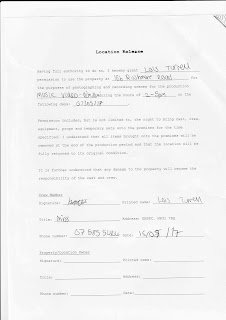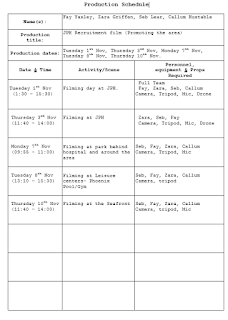Single Camera Techniques
In this essay I will be discussing the key terms of single camera techniques used in film and TV production, I will be defining the key advantages and disadvantages of each term, and the difference between single camera and multi-camera production.
Camera is the first key term, the camera acts as the tool, it adds realism and to creates a more intimate feel. Single camera production only uses one camera, this helps get the audience into the action rather than seeing it from different cameras, they get to follow the one single camera around. This also allows the director to become creative with angles and shots. The intimate feel makes the footage more delightful for the audience it will draw them in to the story. They can only see what that camera is seeing rather than jumping from second camera in editing, they have to wait to see what comes next.
Using a single camera means filming the same scene over and over, so the filmmaker can get the scene from different angles, this makes it looks like there could be a second camera but its just the scene re-acted over again in the exact same way. Using a single camera gives the director more control the shots can be set up individually and this allows you to shoot almost anywhere as space for other cameras would not be an issue. This is a great advantage, it allows the director to think of more locations and has more room for his shots.
The obvious disadvantage is that shots will have to be repeated for different angles, this can be very time consuming for the director and the actors involved in the production, this is why multi-camera production can be handy, it allows the scene to be shot from different angles saving time when re-doing shots. Only using one camera can not only be time consuming but in theory cost more, as if its film it will cost to develop and for the film reel.
Lighting is the second key term I am going to talk about, this term Is very important, it makes the scene look and feel realistic, although the camera can do that, with out the correct lighting the shots will look bland. In a single camera production the lighting is much easier to control, the lighting can be adjusted to the shot type or angle, where as the multi-camera would have the lights adjusted to the cameras this making the production difficult and the scene will have less space.
Using a reflector can help in the production is low budget, the can allow for some light, natural or artificial reflect towards the object or subject used, this will develop the realism of the mood. This can also make shots look similar. This is handy when you are filming in a different location but you want the lighting to be the same.
News programmes use a great amount of lighting to perfect their shots, they will do this by using three-point lighting this is where everything that is dark on the object or subject is covered in a triangle shape, the three points include back light, key light and fill light.
Lighting can also be used to dim the mood, for example in a horror, the camera could be facing the subject and to the left is the key light and to the top right of the subject is a reflector this is a basic example of low key lighting.
In a multi-camera production, maintaining the light can be quite difficult as there are many cameras involved not just one, this is one of the main disadvantages of multi-camera and good disadvantage for single camera.
Sound is the third key term I will be talking about for single camera techniques, sound can range from diegetic to non-diegetic. In single camera productions, sound can be easily developed, it is also a lot cheaper using sound in a single camera than multi-camera. This links back with the camera technique at the start of this essay, due to having only one camera, shots will have to be repeated this means that you have several attempts of getting the perfect sound, especially if the sound is dialogue.
The main way to shoot dialogue on a single camera production is through a shot gun mic, The microphones are designed to collect clear audio from far distances as well as any audio around the mic. The shot gun mic, can either be attached to the camera or on a boom pole, this will increase the distance of sound collected, shot gun mics from a boom pole are mainly used in TV programmes like, EastEnders, Coronation Street and Hollyoaks.
In most TV and film productions the sound may not even come from the footage recorded on the camera, it will be recorded in post, or may be used from another take if the shot had to be repeated.
Editing is the fourth single camera technique I will be explaining, Post production is important for any production whether its single camera or multi-camera. This proceed can take a long time depending on how much footage there is to look through.
One of the main advantages of editing on a multi-camera production is that is can be cheaper as it takes far less time to film, giving more time for post production. In single camera productions most scenes are filmed together, this could be in a specific location or if similar cast members are needed. This can be an advantage in the editing stage as finding the clips will be easier as they will be in order of the scenes you shot them in.
Shot logs come in handy when editing lots of footage as you can work out which takes were successful and which ones could be problematic. A shot log is a list of shots captured and a description of each short according to how well the shot worked out.
Multi-camera productions such as Britain's got talent the cameras can be switched through a vision mixer, this is live editing, moving from one camera to another. The cannot be done with a single camera production and can restrict some productions from shooting live.
The fifth term I will be talking about is single camera genres and formats, and why do certain genres lend themselves to either single camera or multi-camera productions. There are many genres within Film and TV that single camera productions can fit into, but some will not work as they need multi-camera to make the production look realistic.
Period Drama sometimes known as costume drama, is set in a specific era in the past. This type of production can be very costly, as you are going back in time, so costumes, set and props will all need to be taken into consideration and lighting will also need to be discussed. This can be tricky to do with a Period Drama, but it can be done scenes will have to be filmed repeatedly to get different angles, and choice of location will be easier as only one camera will need to be positioned.
Crime is the second genre that can be associated with single camera productions. Crime often uses low key lighting as mention above. This is simply done by using a reflector which is often a lot cheaper than buying more lighting equipment. TV programmes such as Silent Witness and CSI are single camera productions, just moving one camera round and repeating the scenes.
Horror is the third genre, single camera productions are very useful in horrors as it creates the realistic feeling, the audience get scared if something seems too real, that they are there with the actors, single camera in horror does this. Halloween (1978) uses a lot of P.O.V shots this creates suspense, This makes it look like the killer is hidden and makes the footage shaky, Low key lighting is also used in horror movies, although it is cheap it is very effective.
Comedy is another genre that links with both single camera and multi-camera productions. Scrubs TV programme is filmed using single camera techniques but shows like Friends is multi-camera and filmed in front of a live studio audience. Scrubs is set on real locations and will only really require a single camera, this broadens the choice for locations.
Soap operas are mainly filmed using multi-camera techniques this is due to the rate in which the show needs to be directed and produced. Although some soap operas can be shot using single camera techniques, but this is a lot harder to pull off. Brookside was a UK single camera soap this used real locations.
Series is a run of episodes that will eventually end. A good example for this is Silent Witness, this is a series that runs once a year, for four weeks. The programme has part one on a Monday and part two on a Tuesday and the following week will be a completely different plot. You will be presented with a different crime, and different characters but will stick with the main four characters that have been introduced from the start. Silent Witness is a single camera production.
Serial is a TV programme that runs continuous, an good example of this is a soap, for example EastEnders, Coronation Street and Hollyoaks. They do not have series finales. Coronation Street is the longest running British serial, they mainly use multi-cameras due to how quick they have to be produced as some run every night, Hollyoaks runs every night Monday to Friday.
Single Drama, uses one self-contained story, its told in a one off episode, but some can run over two or three parts, depending on the length of the TV programme.
With Multi-camera techniques the actors can seem stale, as they have not had much practice adapting their character, where as a single camera, the actor will have to go over each scene over and over so the director can get shots from different angles this helps improve the actor getting into character.
The filming process takes less time when filming multi-camera as there are more cameras to do different angles so it takes longer time if using just a single camera.
Continuity errors can be come common when shooting single camera as the camera has to be moved around where as in multi-camera the camera's can be set up so that continuity mistakes cannot be made.
With single camera shots the lighting as mentioned above can be controlled more, it is more intimate as there is just one single camera, where as in a multi-camera production there are many lights and this will be costly and more hassle.































